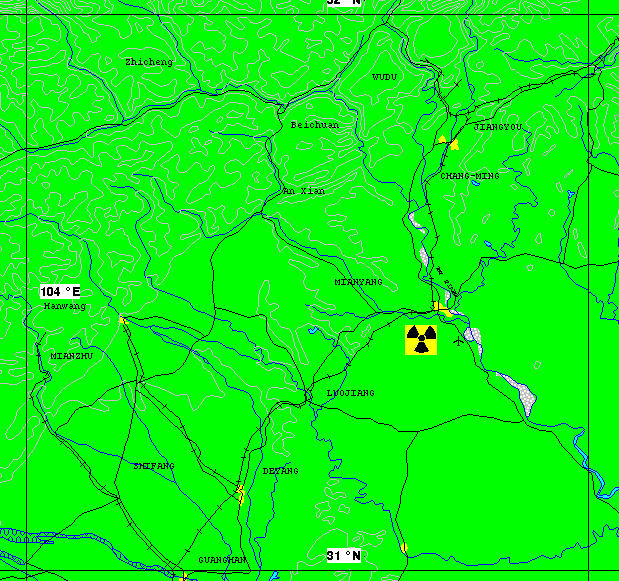





The Chinese Academy of Engineering Physics, also known as the Southwest Institute, is the primary design laboratory for Chinese nuclear weapons, located in Mianyang (Sichuan). Mian Yang city lies on the northern tip of the Chengdu Plain.
In the late 1960s as part of the "third line" effort to relocate critical defense infrastructure in the relatively remote interior, China built new [allegedly underground] facilities supplement the plutonium production reactor at Jiuquan [third line plutonium production reactor at Guangyuan ], the design and fabrication facility at Haiyan [third line design and fabrication facility at Mianyang ], and the gaseous diffusion plant at Lanzhou [third line plutonium processing facility at Yibin ].
The initial identification by US intelligence of the Mianyang [Tzu-t'ung] complex as a nuclear weapons fabrication center rested on the presence there of many revetted buildings and three high explosive test points similar to those at Haiyan, the overall size of the installation, and the pattern of dispersal of the facilities. It was initially difficult to determine the operational status of the complex because most of the available photography was small scale. It did appear to be complete in early 1971 and some portions could have been available for use as early as 1968. While precise analysis of the functions of Mianyang awaited higher resolution photography, it seemed clear in 1972 that the complex represented a major increase in China's weapons fabrication capabilities. The Mianyang complex was built to provide strategic duplication and dispersal for both R&D and production. There is some evidence the Chinese attempted to reduce the vulnerability of the complex to bombing. They have strung the buildings along narrow valleys and meticulously minimized the disturbance of the local terrain features and agricultural patterns. Koko Nor, on the other hand, is highly visible.
In the 1980s and early 1990s, informal professional contact between scientists in the US Department of Energy (DOE) laboratories and the China Academy of Engineering Physics (CAEP) generated interest in creating an institutional framework for technical cooperation between nuclear scientists in the US and China. After careful consideration by both governments and meetings between the directors of the research institutions involved, it was determined that the DOE nuclear laboratories and their counterpart research facilities in China have many mutual interests. Leaders on both sides became convinced that a program of technical exchange could lead to advances in science and technology applications of interest to both countries while contributing to greater understanding and trust between the US and China. Thus, the US-China Lab-to-Lab Program was formally established in 1995 through a letter exchange between Professor Hu Side as President of CAEP; Dr. Al Narath as President of Sandia National Laboratories (SNL); Dr. Siegfried Hecker as Director of Los Alamos National Laboratory (LANL); and Dr. Bruce Tartar as Director of Lawrence Livermore National Laboratory (LLNL). Since 1995, the program has sponsored exploratory workshops in the following areas: MPC&A technologies; application of technologies for verification of the Comprehensive Test Ban Treaty; cooperative monitoring technologies; atmospheric modeling; and the role of nuclear scientists in controlling nuclear technologies. In addition, program participants have hosted scientists at conferences and meetings in both the US and China. As a result of these early explorations, the participants were determined to pursue a joint demonstration of the application of MPC&A technologies at a facility in China as the flagship project.
The Russian Ministry of Nuclear Power Industry and the Chinese Academy of Engineering Physics signed an agreement, on 19 November 1994, for research, technical and economic cooperation in the conversion of defence enterprises and civil use of nuclear power. Based on it is an exchange of research and technical information and personnel. Over 30 contracts were made for high-tech exports to China. A bilateral commission was established for military industry shift to civil-oriented production. It assists research institutes and industrial companies to use high-tech know-how for joint R&D, production and sales.
According to Chinese press reporting, a Sino-Russian symposium on nuclear research for peaceful purposes was held in Chengdu during April 1993 and a Sino-Russian symposium on peaceful nuclear explosions was held at a China Academy of Engineering Physics Institute in Beijing during late 1995. The first symposium probably involved nuclear weapon researchers but primarily dealt with civilian nuclear applications. The latter conference undoubtedly involved mainly nuclear weapon researchers from both countries and dealt with such civilian applications of nuclear explosives as changing the course of rivers and creating electrical power. According to Russian press in April 1996, the deputy minister of Minatom stated that individuals whose work is in defense-related nuclear technologies cannot travel abroad unless given permission by Minatom. Therefore, it can be assumed that any Russian assistance given to the Chinese nuclear weapons program has been approved at the ministerial level.
The Institute of Nuclear Physics and Chemistry (INPC), located in Sichuan Science City in Mianyang, is a comprehensive institute with multiple disciplines, mainly nuclear physics, radiochemistry and plasma physics. It has 1,460 employees, including 694 technical personnel (22 research fellows, 219 senior engineers, 243 engineers, 35 graduate students). INPC's main facilities include key high-temperature and high-density plasma physics laboratory, thermal-neutron experimental reactor, pulsed fast neutron reactor, high-power laser installation, and various accelerators.

